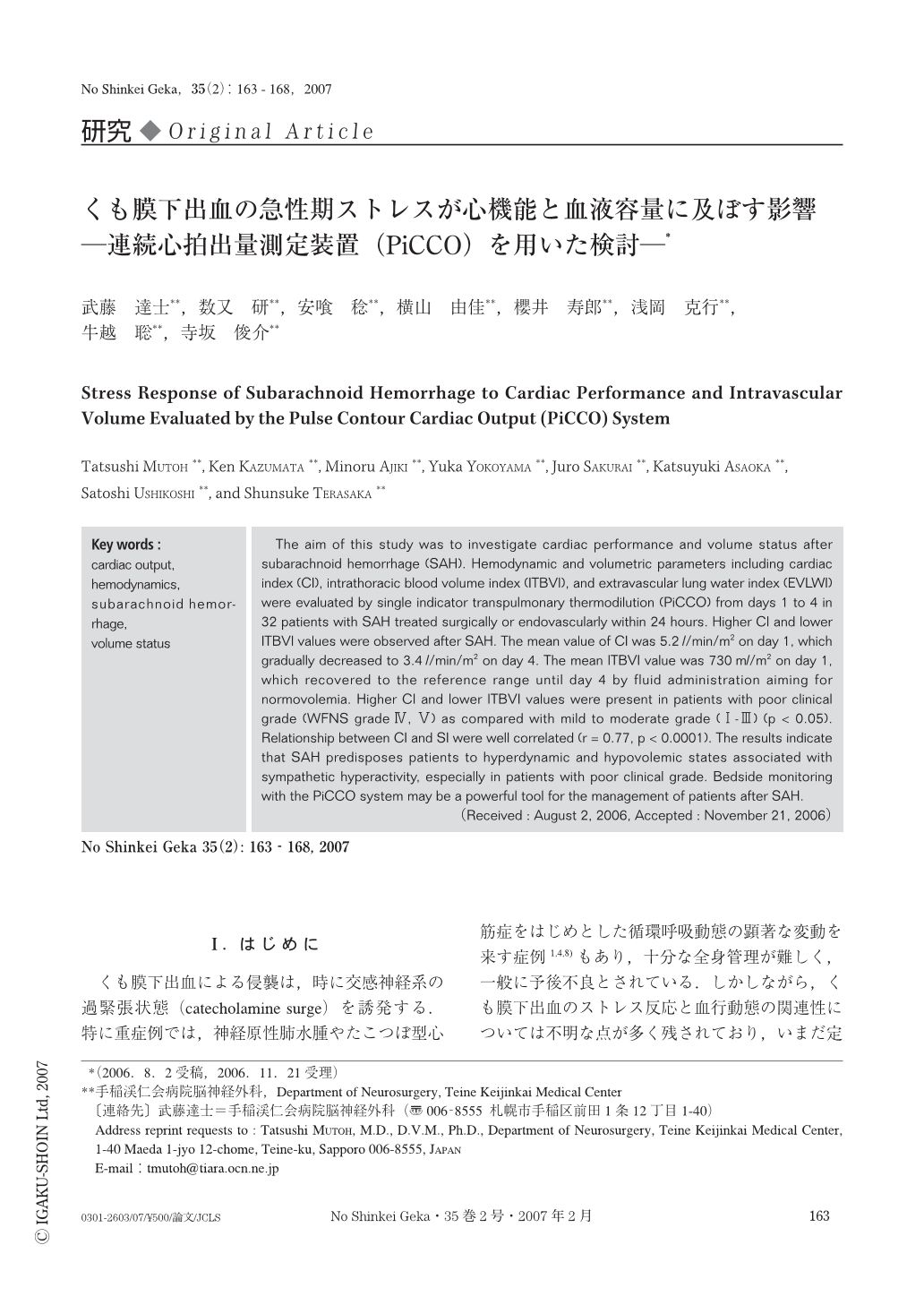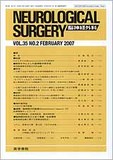Japanese
English
- 有料閲覧
- Abstract 文献概要
- 1ページ目 Look Inside
- 参考文献 Reference
Ⅰ.はじめに
くも膜下出血による侵襲は,時に交感神経系の過緊張状態(catecholamine surge)を誘発する.特に重症例では,神経原性肺水腫やたこつぼ型心筋症をはじめとした循環呼吸動態の顕著な変動を来す症例1,4,8)もあり,十分な全身管理が難しく,一般に予後不良とされている.しかしながら,くも膜下出血のストレス反応と血行動態の関連性については不明な点が多く残されており,いまだ定まった管理法が確立されているとは言い難い.特に,脳血管攣縮のような脳循環に顕著な変動を来す時期における不完全な病態の把握は,患者の予後を左右する致命傷ともなり得る.
最近われわれの施設では,くも膜下出血患者を対象として,術直後から脳血管攣縮期にかけて,肺経由動脈熱希釈法(single indicator transpulmonary thermodilution)による連続心拍出量モニタリング装置(PiCCO TM plus;Pulsion Medical Systems社製)を用いた循環管理法を導入している1).これまで循環血液量の評価として,観血的動脈圧および圧波形,中心静脈圧(central venous pressure;CVP),肺動脈楔入圧(pulmonary capillary wedge pressure;PCWP)などの圧指標や胸部X線写真などの画像所見,呼吸状態,水分出納表,体重,血圧などを用いて評価してきた.しかし容量-圧関係は必ずしも直線的ではないため,正確な容量評価には圧変化よりは直接容量の変化を捉えるほうが好ましいと考えられる.PiCCOは,冷却水を用いた肺経由熱希釈法(transpulmonary thermodilution)で心拍出量を測定し,これを基に動脈圧波形解析法(arterial pulse contour analysis)から心拍ごとの拍出量を連続測定できる機能を有する.さらに,熱希釈法のみから心拍出量のみならず,血管内容量に関する様々なパラメータを測定することが可能であり2,9),くも膜下出血の脳血管攣縮期における心機能および水分管理に適した装置といえる.今回,重症くも膜下出血患者を中心として,同モニタリング装置により得られた心機能・血液容量ならびにストレスに関する血液データに基づき,くも膜下出血による急性期ストレスについて解析を行ったので,その中間結果を報告する.
The aim of this study was to investigate cardiac performance and volume status after subarachnoid hemorrhage (SAH). Hemodynamic and volumetric parameters including cardiac index (CI), intrathoracic blood volume index (ITBVI), and extravascular lung water index (EVLWI) were evaluated by single indicator transpulmonary thermodilution (PiCCO) from days 1 to 4 in 32 patients with SAH treated surgically or endovascularly within 24 hours. Higher CI and lower ITBVI values were observed after SAH. The mean value of CI was 5.2l/min/m2 on day 1, which gradually decreased to 3.4l/min/m2 on day 4. The mean ITBVI value was 730ml/m2 on day 1, which recovered to the reference range until day 4 by fluid administration aiming for normovolemia. Higher CI and lower ITBVI values were present in patients with poor clinical grade (WFNS gradeⅣ, Ⅴ) as compared with mild to moderate grade (Ⅰ-Ⅲ) (p < 0.05). Relationship between CI and SI were well correlated (r = 0.77, p < 0.0001). The results indicate that SAH predisposes patients to hyperdynamic and hypovolemic states associated with sympathetic hyperactivity, especially in patients with poor clinical grade. Bedside monitoring with the PiCCO system may be a powerful tool for the management of patients after SAH.

Copyright © 2007, Igaku-Shoin Ltd. All rights reserved.


